Your company's product launch or marketing initiatives generally involve various planning strategies to ensure their effectiveness. One includes the SWOT analysis template, which lets organizations identify the areas to focus on.
The SWOT analysis template is essential for project management and strategic planning. Furthermore, it allows teams to look closely at internal and external elements affecting business and maximize on factors that can assist your organization to stay ahead of the tough competition.
What is a SWOT analysis?
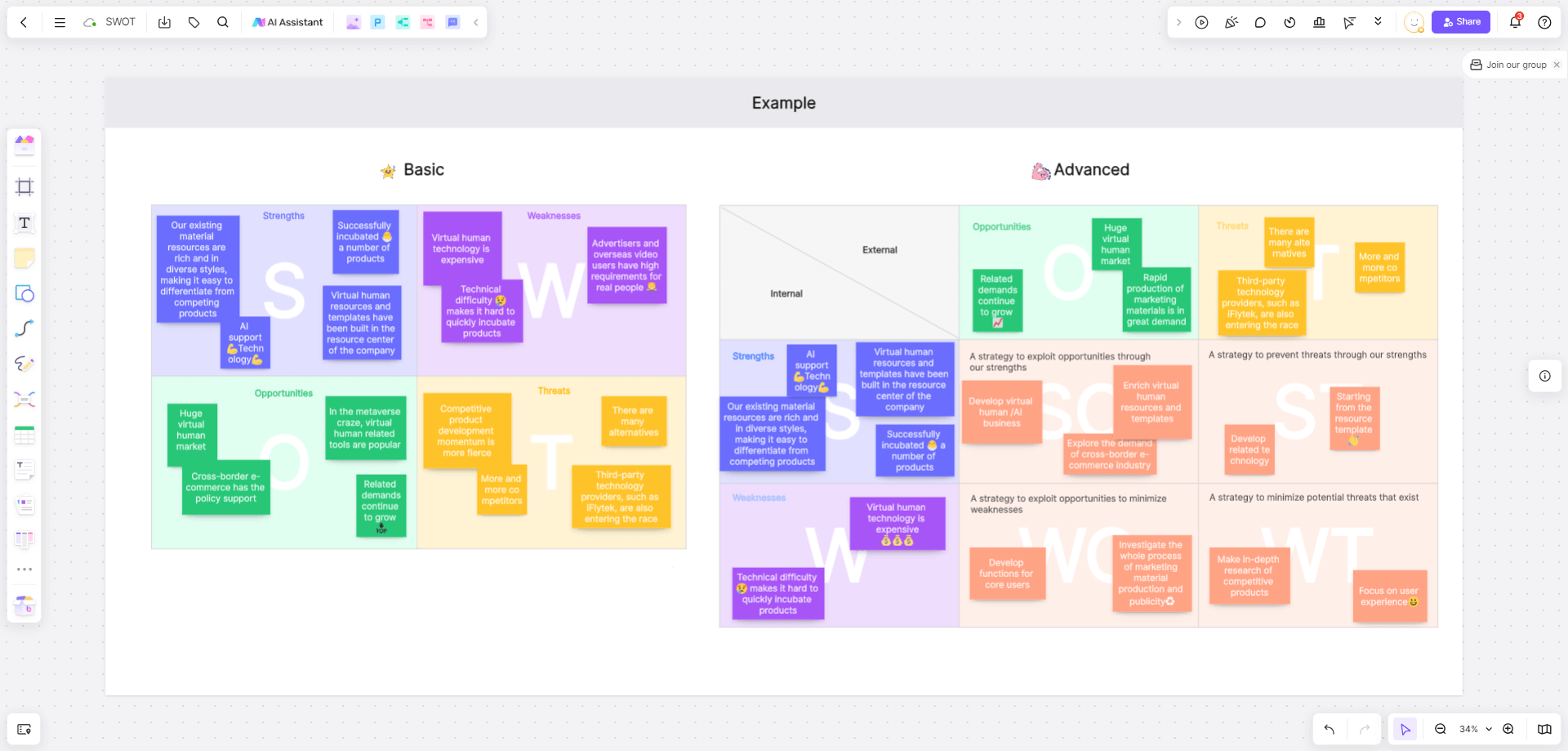
The SWOT analysis refers to Strengths, Weaknesses, Opportunities, and Threats. It is a straightforward evaluation model. Most organizations use this framework to identify integral strengths and weaknesses. Also, this method will help companies and organizations understand their current status and how they can start moving forward with the business.
Most teams perform a SWOT analysis regularly. Some even hold bi-annually or when companies must make a significant decision. However, it will significantly differ according to the business needs. For example, one can analyze SWOT before creating a new product. Through this, you will better understand the potential opportunities and hurdles ahead based on your company's current positioning against the competitors.
History of SWOT Analysis
The SWOT concept was initially derived from Lockheed's corporate development planning department in 1952. There is technically no specific creator of the SWOT analysis. Some also credit the idea to Albert Humphrey. Regardless, SWOT has greatly helped various organizations and companies, and the concept has evolved since it was first conceptualized.
SWOT analysis also has received recognition for helping establish and differentiate a specific niche within broader markets. Besides the corporate setup, the SWOT concept has also been used at the individual level to evaluate a person's situation against the competition.
What does the acronym SWOT stand for?
SWOT means Strengths, Weaknesses, Opportunities, and Threats. On your SWOT analysis template, you will generally have four sections, and remember to fill in every component. Otherwise, it defeats the purpose of the diagram.
You can arrange each component vertically or horizontally. It is all up to you. With digital diagramming tools, you can create a SWOT analysis template by customizing colors, and layout, and the software even allows you to include special characters, photos, or stickers.
What are the components of a SWOT analysis?
As previously mentioned, a SWOT analysis template has four essential components. See the list below.
- This refers to the qualities which help companies achieve their objectives. The qualities can include tangible and intangible elements; through them, you can ensure continued success in the company. The details you can write in this section mainly include the employees' process capabilities, competency levels, brand loyalty, products and services, customer goodwill, and financial resources. In terms of organizational strengths, you can include committed employees, a broader product line, sufficient financial resources, and an absence of debt.
- These are organizational or individual qualities that keep you from achieving the fullest potential of your objectives. In short, these aspects fall below the standards the team envisions. They may include inadequate research and development for the company's products and services, poor decision-making, depreciating machinery, and a narrow product range.
- The details under this component are the areas for improvement and success in the business environment. Once the team recognizes these factors and acts upon them, you can ensure some competitive edge over competitors. There must be a thorough examination to recognize them since opportunities arise from various areas, including competition, the government, the market, or the nature of the industry.
- This is the final section of your SWOT analysis template. The inputs here include the things that could jeopardize the efforts of the company to attain reliability and profitability. Threats are often uncontrollable and may put the organization's stability and survival to the test. They can be seen in industry price wars, unfavorable rules and regulations, constantly changing prices, evolving technology, and cutthroat competition.
SWOT Analysis Examples
Personal SWOT Analysis Example
The first of the personal SWOT analysis examples that we are going to examine is focusing on self-assessment. This freelance graphic designer has conducted a personal SWOT assessment to evaluate how successful they are in their career and what they need to do to grow further.
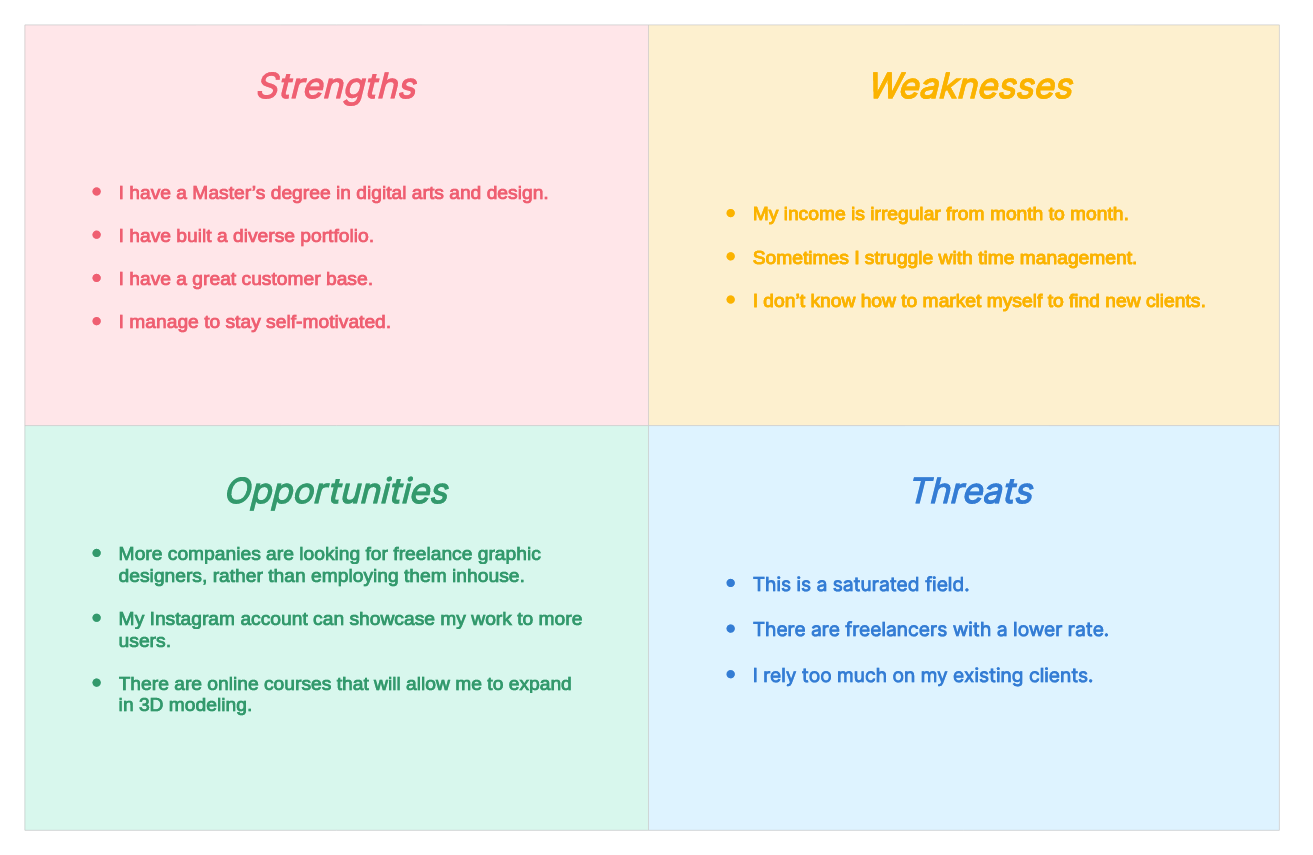
Business SWOT Analysis Example
In business planning, SWOT analysis serves multiple crucial functions. Firstly, it aids in setting realistic objectives and formulating effective strategies to achieve these objectives. The analysis of strengths and weaknesses helps organizations identify areas of competitive advantage as well as areas that need improvement or restructuring.
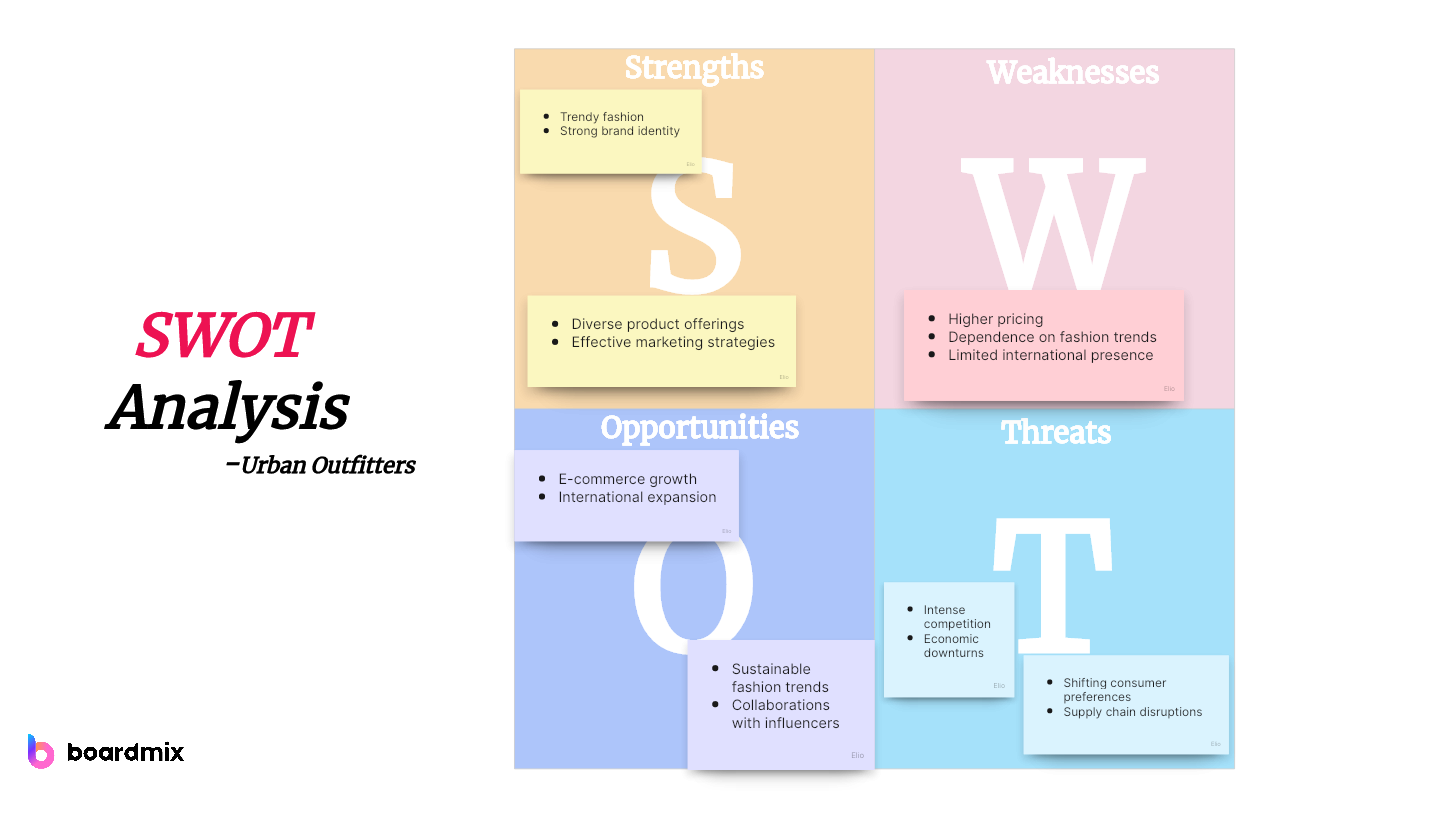
SWOT Analysis of Food Business
Conducting a SWOT analysis for the food business is pivotal in navigating the competitive landscape of the culinary industry. This comprehensive assessment encompasses internal strengths and weaknesses, as well as external opportunities and threats specific to food-related enterprises.
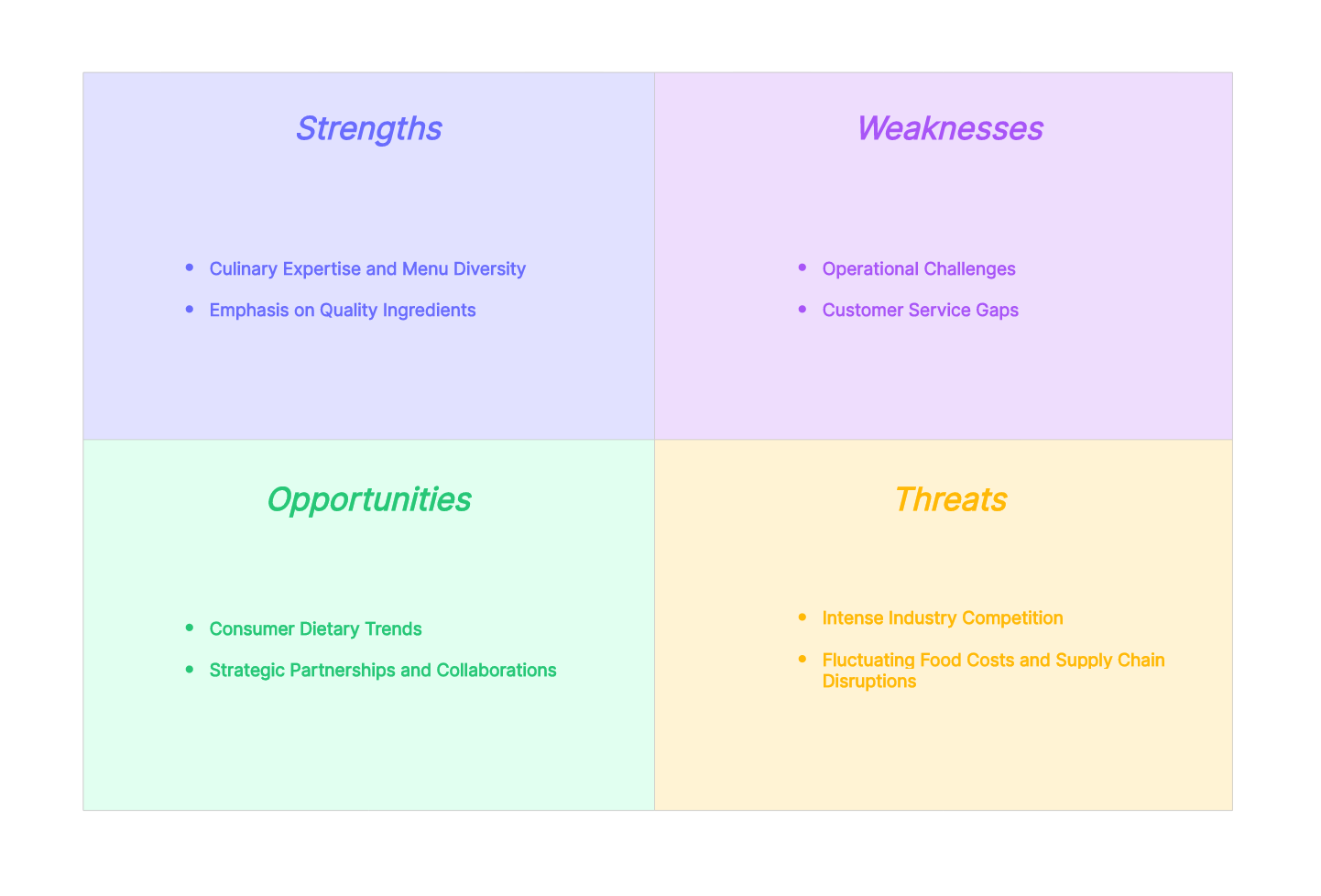
How to write a SWOT analysis?
Creating a SWOT analysis template is easy. There are pre-made templates online you can use. The structure is already there; you only need to place details for every quadrant. Here are some essential steps to write an effective SWOT analysis.
- Identify the objective. There are times when the company objectives are broad. If this happens, you must select and prioritize your objectives. They may focus on deciding whether to perform another product rollout. With goals in mind, your company will be guided on what you aim to attain at the end of the process.
- Gather resources. The resources can be datasets that can support the creation of different SWOT analysis templates. Companies must begin by understanding the information they have access to, the data limitations, and the reliability of external data sources. Resources also involve your workforce. Organizations should develop the right employee combination to create the SWOT analysis template.
- Collate ideas. In most cases, each quadrant of the SWOT analysis template will be assigned to a specific individual or group. Ensure to list ideas within each category. It also pays to have some guide questions. If you want to do it conventionally, use sticky notes and a whiteboard. Diagramming software can also be useful for a more efficient whiteboarding process.
- Refine the findings. There are no wrong inputs when your team collates the ideas to develop the SWOT analysis template. However, during this stage, it is time to refine the ideas. This way, the company can focus on the best inputs related to the company's goal. Expect thorough brainstorming among participants; some even bring in the upper management to help in ranking the priorities.
- Developing the strategy. After ranking the list under the strengths, weaknesses, opportunities, and threats section, you can use the SWOT analysis to develop a strategic plan. Team members can have a bulleted list of items for each category and make a synthesized plan that can guide the primary objective.
What are the benefits of using a SWOT Analysis?
Using the SWOT analysis may not resolve every concern within the company, but there are significant reasons why you still need to develop this framework within the organization.
- SWOT lets companies manage complex problems. Whether it is a small or large company, you can expect vast amounts of data to analyze and significant points to consider when making complex decisions. A well-curated SWOT analysis can rank the importance of ideas, transforming them into a much more straightforward and digestible report.
- You can create a SWOT analysis template for every business question. The analysis can be helpful in an organization, individual, or team. Furthermore, it can analyze product lines, geographical expansion, acquisition, or brand changes. It is a versatile tool with various applications.
- In most cases, a SWOT analysis is cost-effective. You need not be overly technical when creating the SWOT analysis template. As a result, several team members can provide their inputs to the analysis preparation without external consulting or training.
- A SWOT analysis allows companies to maximize data sources. This means you are not solely basing the details of the analysis on one biased source. As you know, strengths and weaknesses can be collected internally, while other external sources relating to competitors, broad markets, and macroeconomic forces are useful for opportunities and threats.
- The SWOT concept lets you challenge assumptions. Developing an excellent analysis requires complete honesty from those involved, and questions must be answered objectively. As a result, your team gains more accurate perspectives of the organization and competitors. This leads to a higher probability of a company's success and growth.
How to Conduct a SWOT Analysis: A Step-by-Step Guide
SWOT analysis is a cornerstone of strategic planning, offering companies a clear overview of their Strengths, Weaknesses, Opportunities, and Threats. For modern companies, leveraging digital tools like Boardmix can help streamline and optimize the SWOT analysis process. Here is a step-by-step guide on how to conduct a SWOT analysis using Boardmix.
Setting Up Your SWOT Analysis
After logging in to Boardmix, you'll want to navigate to the dashboard. Here, you'll find an option to create a new board with the template, choose “SWOT Analysis” to get started.
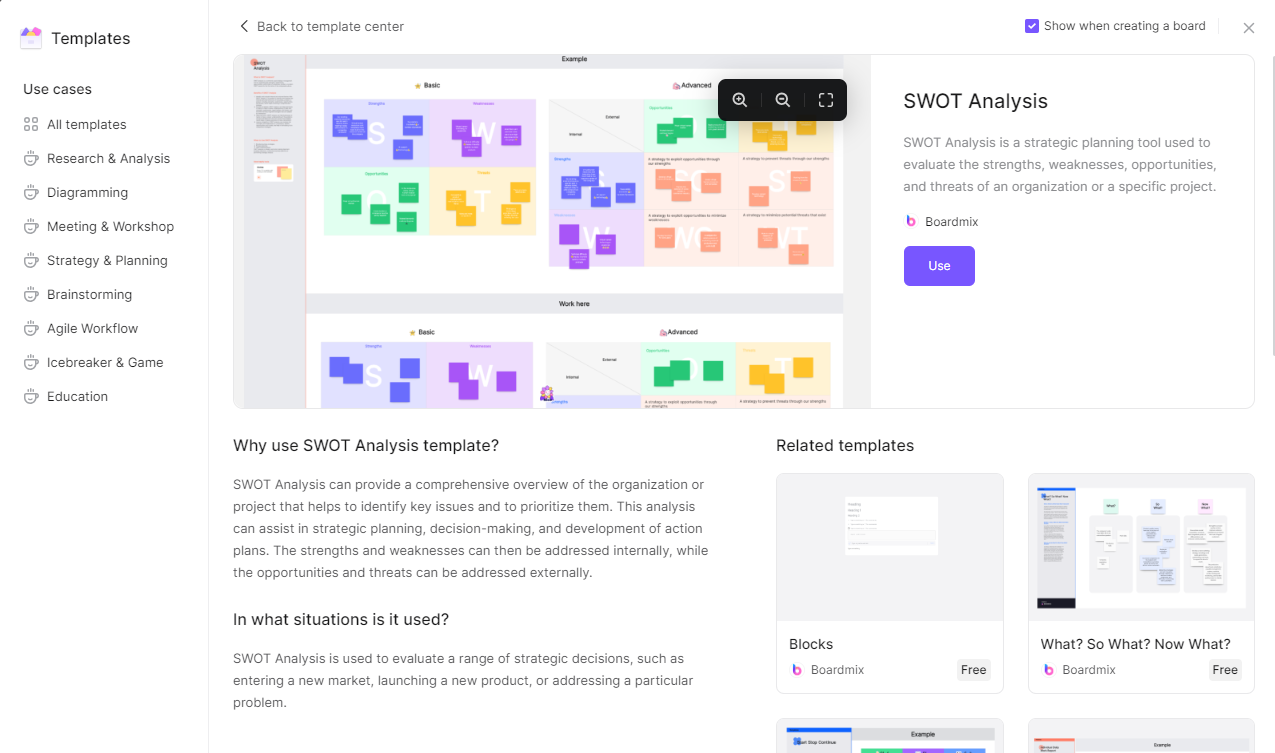
Create a Free SWOT Template
After registering for Boardmix, click "Community" to enter the Boardmix template community, then enter "SWOT" in the search box to customize the name of the project, and click "Use this template".

Customize Your SWOT Template
The SWOT analysis template consists of four colored cards named: Strengths, Weaknesses, Opportunities, and Threats, which are divided into two scenarios, internal and external. You can list the weaknesses, threats, strengths, and opportunities that the company/product is currently facing from both internal and external sources, and write at least 2 aspects for each module.
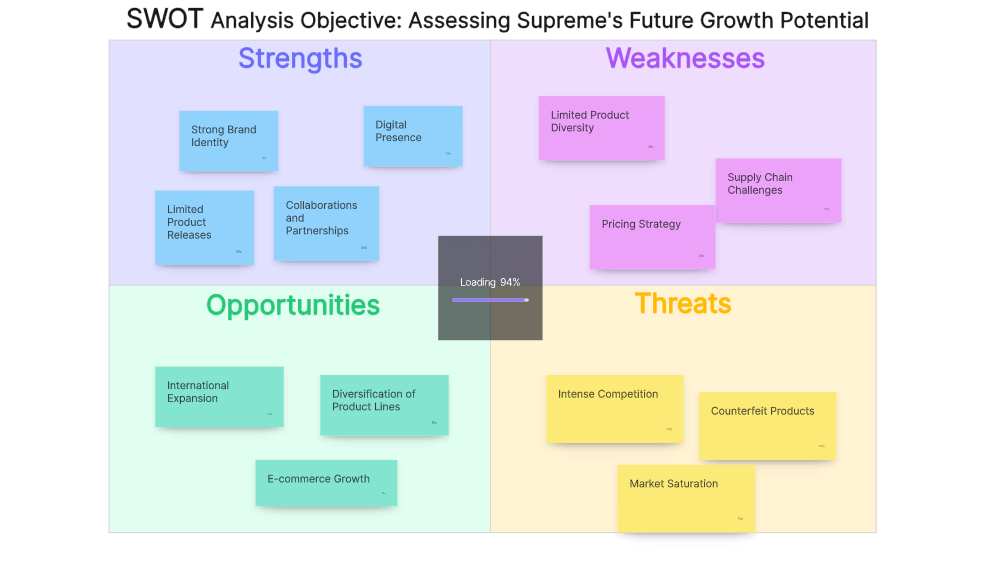
Share SWOT Analysis
After completing the SWOT analysis, the Boardmix whiteboard can support one-click file sharing, helping you quickly share the analysis results with team members through invitation links. You can control access settings and decide who can edit or view the project. On the other hand, you can also share your projects publicly with the Boardmix whiteboard community for everyone to learn and communicate with. At the same time, the "Export" option is provided to facilitate local storage of works.

FAQs about SWOT analysis
What is the main purpose of the SWOT analysis?
The primary purpose of the SWOT analysis concept is to determine factors affecting an organization's functioning and provide helpful information in the strategic planning process. Along the way, the analysis can help companies to have informed and careful decision-making processes. While you might see four components in a SWOT analysis template, your team can divide the framework into two parts. This includes the internal environment, which focuses on the strengths and weaknesses. Meanwhile, opportunities and weaknesses can be identified using external factors.
With SWOT analysis, an organization can also assess its team members to understand them better. For example, the analysis might help them evaluate their skills and determine some areas for improvement. You can use this concept to assess yourself toward achieving personal goals.
Why is a SWOT analysis important?
Businesses use the SWOT analysis as it allows them to quickly adapt to evolving market trends. Since the concept lets you identify strengths, your business can penetrate specific markets and meet targets. Furthermore, if you know the company's weaknesses and areas for improvement, mitigating future roadblocks will be easier.







